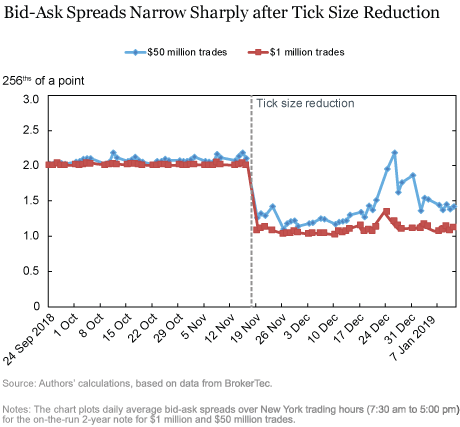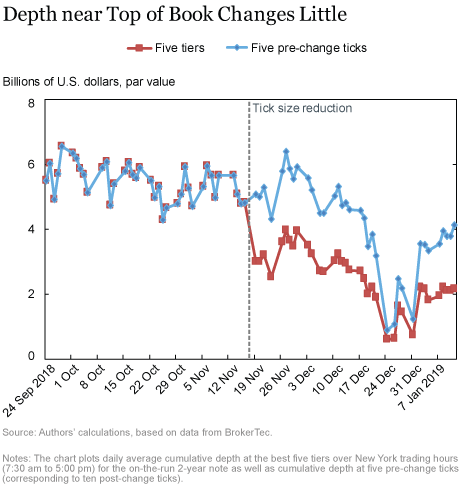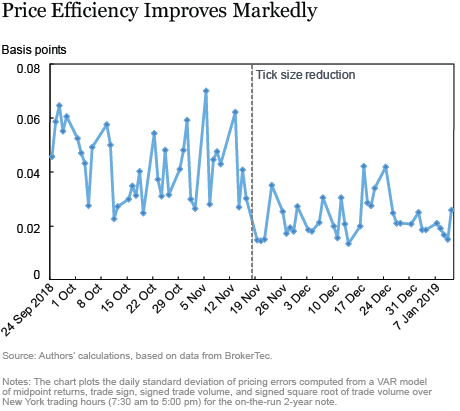The popularity of U.S. Treasury securities as a means of pricing other securities, managing interest rate risk, and storing value is, in part, due to the efficiency and liquidity of the U.S. Treasury market. Any structural changes that might affect these attributes of the market are therefore of interest to market participants and policymakers alike. In this post, we consider how a 2018 change in the minimum price increment, or tick size, for the 2-year U.S. Treasury note affected market quality, following our recently updated New York Fed staff report.
Market Structure
Treasury securities trade in multiple venues—a dealer-to-customer segment, a dealer-to-dealer segment, and an interdealer broker (IDB) segment, as discussed in this Liberty Street Economics post. In the IDB segment, 70 percent of trading volume goes through fully electronic interdealer brokers and the remaining 30 percent through voice brokers, as shown in this post. The BrokerTec platform, in particular, accounts for roughly 80 percent of activity among the electronic brokers, as estimated by Greenwich Associates.
Fractional Pricing
Unlike U.S. equity markets, which switched to decimal pricing in 2001, U.S. Treasury securities still trade in fractions. In particular, prices are quoted in 32nds of a point, where a point equals one percent of par, with the 32nds themselves split into fractions. On the BrokerTec platform, for example, 3- and 5-year notes trade in quarters of 32nds, whereas 7-, 10-, and 30-year securities trade in halves of 32nds. The quoted price for a 5-year note might be 98-15¼, for example, indicating a price in decimal form of 98.4765625 (that is, 98 + 15⁄32 + ¼⁄32).
The Tick Size Change
Effective November 19, 2018, BrokerTec halved the tick size in the 2-year note from ¼ to 1⁄8 of a 32nd. This was the first tick size change since the platform’s inception in 2000. Interestingly, the tick size on the 2-year note futures contract was also halved to 1⁄8 of a 32nd, albeit eight weeks after the BrokerTec change, on January 14, 2019. (Note that BrokerTec is owned by the CME Group, which operates the Treasury futures market.) Tick sizes of other securities remained unchanged, allowing us to use those securities as controls in our analysis.
What Have Past Studies Found?
Many studies have assessed the effects of tick size on market quality in equity markets, as described in our paper. They generally find evidence that a smaller tick size leads to narrower bid-ask spreads, reduced depth, and improved price efficiency. That said, effects are found to vary across trader types and market structures, highlighting the benefit of looking at the effects across different markets. Moreover, a particular advantage of looking at the Treasury market is that it has a liquid and tightly linked futures market, allowing us to examine how the tick size change affected the relative importance of the cash and futures markets for price discovery.
How Was Market Liquidity Affected?
As shown in the chart below, the finer price increment resulted in an immediate narrowing of the inside bid-ask spread, defined as the difference between the best bid and offer prices on the BrokerTec platform. In fact, the spread for the smallest trades ($1 million) narrowed about 50 percent, from an average just slightly wider than the old tick size to an average just slightly wider than the new tick size. The spread for larger trades ($50 million or more) showed a similar narrowing. That is, trading costs declined with the tick size change, even for trades that are sometimes larger than the quantity available at the best price. The reduction in trading costs, in turn, spurred a significant increase in trading activity.

Depth near the top of BrokerTec’s limit order book, in contrast, changed modestly when measured at a fixed distance from the bid-ask midpoint. As shown in the next chart, average cumulative depth at the five best bid and offer prices did decline noticeably after the tick size reduction, but this is not a fair comparison because of the finer pricing grid in the post-change period. When we instead measure depth within 5⁄4 of a 32nd (that is, five units of the old tick size) of the bid-ask midpoint, we find that average cumulative depth changed more modestly (although it did decline at the end of the year, as is typical). Consistent with these results, we find no significant change in the price impact of trades after the tick size change.

How Was Market Efficiency Affected?
We also examine how the smaller tick size affects the flexibility and efficiency of prices. We assess four measures in our paper, but present just one here. In particular, the standard deviation of the pricing error, developed by Hasbrouck (1993), indicates how precisely the observed price reflects the efficient price. It is calculated from a vector autoregression (VAR) model of midpoint returns, trade sign, signed trade volume, and signed square root of trade volume. As shown in the chart below, the magnitude of pricing errors dropped immediately upon the tick size change, suggesting that the finer pricing grid allows for more efficient prices.

A novel aspect of our paper is the assessment of how price discovery shifts between the cash and futures markets. Key to our analysis is the fact that a similar tick size change in the futures market occurred eight weeks after the cash market change. We follow Hasbrouck (1995) in computing the efficient return variance and information share from a vector error correction model (VECM) of cash and futures prices. We find a clear increase in the cash market’s information share after the cash market tick size change, as shown in the next chart. Moreover, the change appears to largely reverse when the tick size in the futures market is halved.

Summing Up
We find that the Treasury market tick size change led to improved market liquidity, improved price efficiency, and improved price discovery relative to the futures market. While many of these findings are consistent with evidence from equity markets, two stand out as new: 1) liquidity provision was seemingly not adversely affected, and 2) the informational importance of the cash market improved, albeit only until a similar change took effect in futures.

Michael Fleming is a vice president in the Federal Reserve Bank of New York’s Research and Statistics Group.
Giang Nguyen, an assistant professor of finance at Penn State University, was a visiting scholar at the Federal Reserve Bank of New York in 2019 and is currently a visiting financial economist at the United States Securities and Exchange Commission.
 Francisco Ruela is a senior research analyst in the Federal Reserve Bank of New York’s Research and Statistics Group.
Francisco Ruela is a senior research analyst in the Federal Reserve Bank of New York’s Research and Statistics Group.
How to cite this post:
Michael Fleming, Giang Nguyen, and Francisco Ruela, “How Does Tick Size Affect Treasury Market Quality?,” Federal Reserve Bank of New York Liberty Street Economics, January 15, 2020, https://libertystreeteconomics.newyorkfed.org/2020/01/how-does-tick-size-affect-treasury-market-quality.html.
Disclaimer
The views expressed in this post are those of the authors and do not necessarily reflect the position of the Federal Reserve Bank of New York or the Federal Reserve System. Any errors or omissions are the responsibility of the authors.
The Securities and Exchange Commission (SEC) disclaims responsibility for any private publication or statement of any SEC employee or Commissioner. This blog post expresses the authors’ views and does not necessarily reflect those of the Commission, the Commissioners, or other members of the staff.










 RSS Feed
RSS Feed Follow Liberty Street Economics
Follow Liberty Street Economics
Thank you for your comments. Yes, the evidence suggests that the new tick size is often binding, albeit to a lesser extent than the old tick size. That said, there is evidence from other markets that the tick size can be too small (see our underlying New York Fed Staff report for more details), with a smaller tick size reducing the incentive for liquidity provision and possibly harming liquidity. It’s therefore not necessarily the case that smaller is always better. Moreover, determining the optimal tick size is challenging because liquidity has different aspects and is always changing.
Very interesting, thank you. If the average spread after the cut is “just slightly wider than the new tick size” does this not indicate that the instrument is – even after the cut – still constrained by the tick size? What would be extremely interesting as a follow-up is a comparative study of tick constraints across the top 100 futures products across the various exchanges. It seems to be fairly well established that removing a tick constraint leads to positive investor outcomes so the natural next questions are: 1. How common is this? 2. Why are the frictions to removing tick constraints? i.e. If they are well understood why do they persist for so long?